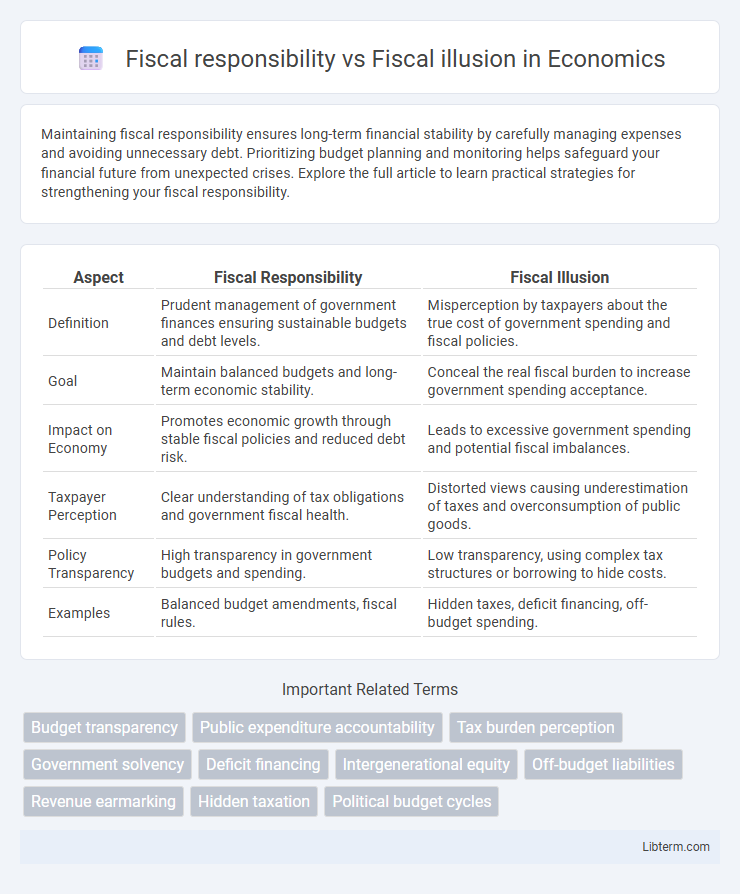Maintaining fiscal responsibility ensures long-term financial stability by carefully managing expenses and avoiding unnecessary debt. Prioritizing budget planning and monitoring helps safeguard your financial future from unexpected crises. Explore the full article to learn practical strategies for strengthening your fiscal responsibility.
Table of Comparison
| Aspect | Fiscal Responsibility | Fiscal Illusion |
|---|---|---|
| Definition | Prudent management of government finances ensuring sustainable budgets and debt levels. | Misperception by taxpayers about the true cost of government spending and fiscal policies. |
| Goal | Maintain balanced budgets and long-term economic stability. | Conceal the real fiscal burden to increase government spending acceptance. |
| Impact on Economy | Promotes economic growth through stable fiscal policies and reduced debt risk. | Leads to excessive government spending and potential fiscal imbalances. |
| Taxpayer Perception | Clear understanding of tax obligations and government fiscal health. | Distorted views causing underestimation of taxes and overconsumption of public goods. |
| Policy Transparency | High transparency in government budgets and spending. | Low transparency, using complex tax structures or borrowing to hide costs. |
| Examples | Balanced budget amendments, fiscal rules. | Hidden taxes, deficit financing, off-budget spending. |
Understanding Fiscal Responsibility: Defining Core Principles
Fiscal responsibility entails managing government budgets with transparency, accountability, and sustainability, ensuring expenditures do not exceed revenues over the long term to avoid excessive debt accumulation. Core principles include prudent budgeting, efficient allocation of resources, and maintaining balanced fiscal policies that promote economic stability and growth. Understanding these principles helps distinguish true fiscal discipline from fiscal illusion, where governments obscure financial realities to mask deficits or debt burdens.
Fiscal Illusion: Meaning and Historical Context
Fiscal illusion occurs when taxpayers misunderstand the true cost of government spending due to complex taxation systems or hidden fiscal policies, leading to higher public expenditure than intended. This concept, rooted in the works of economists like James M. Buchanan and Richard E. Wagner during the 1960s and 1970s, highlights the discrepancy between perceived and actual fiscal burdens. Historically, fiscal illusion has been used to explain why voters support extensive government programs despite rising taxes, as the obfuscation of costs reduces resistance to public spending.
Key Differences Between Fiscal Responsibility and Fiscal Illusion
Fiscal responsibility involves transparent budgeting, focusing on balanced budgets and sustainable debt levels, ensuring long-term economic stability and trust in government financial management. Fiscal illusion occurs when governments obscure true fiscal conditions through accounting tricks or deficit spending, misleading taxpayers about the real cost of public services and future liabilities. The key difference lies in transparency and accountability: fiscal responsibility promotes clear, honest financial practices, while fiscal illusion creates distorted perceptions to avoid short-term political costs.
Common Sources of Fiscal Illusion in Government Budgets
Common sources of fiscal illusion in government budgets include complex tax structures, off-budget activities, and intergovernmental transfers that obscure the true cost of public services. Misleading accounting practices such as deficit financing and the use of special funds create a false perception of fiscal health. These factors distort citizens' and policymakers' understanding of government financial obligations, leading to inefficient resource allocation and excessive public debt.
Impacts of Fiscal Illusion on Economic Stability
Fiscal illusion distorts taxpayers' perception of public spending and borrowing, leading to underestimated government deficits and unsustainable fiscal policies. This misperception often results in excessive public debt accumulation, undermining economic stability and increasing the risk of financial crises. Persistent fiscal illusion can erode investor confidence, cause inflationary pressures, and hinder long-term economic growth.
Transparency and Accountability in Fiscal Policy
Fiscal responsibility emphasizes transparent budgeting processes that ensure clear disclosure of government revenues and expenditures, promoting accountability to taxpayers and investors. In contrast, fiscal illusion occurs when complex or opaque fiscal measures obscure the true cost of public policies, reducing public scrutiny and enabling governments to evade accountability. Enhancing transparency through detailed fiscal reports and independent audits mitigates fiscal illusion and strengthens democratic oversight in fiscal policy decisions.
Case Studies: Fiscal Responsibility in Practice
Case studies of fiscal responsibility highlight countries like Germany and Sweden, where strict budgetary rules and transparent governance have maintained low debt-to-GDP ratios and stable economic growth. These nations demonstrate how disciplined public spending and effective tax policies prevent fiscal illusion, reducing the risk of hidden deficits and unsustainable borrowing. The success of such practices contrasts sharply with cases like Italy, where fiscal illusion has led to chronic deficits and fiscal instability.
Recognizing Fiscal Illusion in Tax and Spending Policies
Recognizing fiscal illusion in tax and spending policies involves identifying deceptive practices that obscure the true cost of government, such as complex tax structures and off-budget spending. These tactics create a distorted perception of fiscal health, leading taxpayers to underestimate their tax burden or overestimate public service benefits. Accurate transparency and straightforward reporting are essential to counteract fiscal illusion and promote genuine fiscal responsibility.
Strategies to Promote Fiscal Responsibility and Reduce Fiscal Illusion
Implementing transparent budgeting processes and enforcing strict fiscal rules enhances fiscal responsibility by making government finances more understandable and accountable. Educating the public on government spending and taxation reduces fiscal illusion by clarifying the true cost and benefits of public programs. Strengthening institutional frameworks and independent fiscal oversight bodies ensures consistent adherence to responsible fiscal policies and mitigates misleading financial perceptions.
The Role of Public Awareness in Combating Fiscal Illusion
Public awareness plays a critical role in combating fiscal illusion by educating citizens about the true costs and consequences of government spending and taxation, enabling more informed decision-making. Transparent government budgets and accessible fiscal data empower taxpayers to recognize hidden deficits and misleading fiscal practices, fostering greater accountability. Enhanced financial literacy campaigns increase public scrutiny, reducing the likelihood of unsustainable fiscal policies driven by short-term political gains.
Fiscal responsibility Infographic

 libterm.com
libterm.com